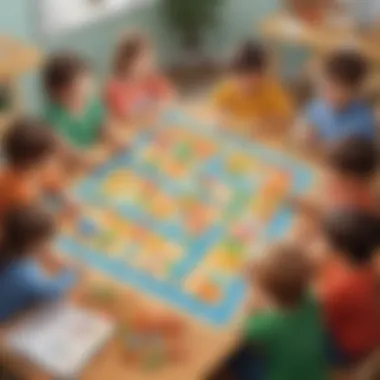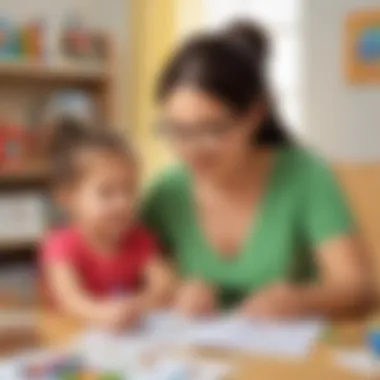Engaging Math Practice for Kindergarten: Free Resources


Intro
In the world of early childhood education, effective math practice lay the foundation for future academic success. For kindergarten pupils, engaging in mathematical concepts can be a delightful experience when the right resources and strategies are applied. To assist parents and educators, this article explores various free resources and practical tactics designed specifically for strengthening math skills in a lively and accessible way.
This guide covers interactive learning games that foster essential foundational skills, tips that streamline the learning journey, multidisciplinary topics promoting a wide range of knowledge, and creative DIY projects that spark imagination and develop cognitive abilities. Each section aims to provide adults with the tools they need to make early math learning a more enjoyable process for young children.
Interactive Learning Games
Games present an engaging avenue for children to sharpen their math competencies without feeling the strain often associated with academic tasks. Interactive learning games capture the interest of kindergarten children while providing accustomed learning environments they can thrive in.
Popular Games
Interactive learning games such as Prodigy Math Game, Sumdog, and ABCya! effectively align with the educational needs of kindergarten students. Each of these platforms offers a range of mathematical challenges specially crafted to address a young user's skill set, creating a stimulating and interactive atmosphere.
Description of top educational games
- Prodigy Math Game: This game harnesses the power of role-playing by allowing kids to answer math questions to progress through an exhilarating fantasy world.
- Sumdog: Sumdog’s fun environment blends games with rigorous math practice tailored to individual learning levels, fostering engagement effectively.
- ABCya!: ABCya! hosts a selection of math games that keep kindergarteners learning while exploring creative themes like space and animals.
Benefits of playing educational games for kids' cognitive development
Educational games not only improve math fluency but also enhance various aspects of a child's cognitive skills. These benefits include:
- Improved problem-solving abilities
- Enhanced memory retention
- Increased focus and attention span
Playing these games provides the learners an opportunity to associate positive experiences with learning. This creates an open and curious mindset that teachers and parents greatly value.
Game Reviews
When choosing educational games, reviews can provide insight. Each game mentioned earlier offers unique beneficial aspects. For example, Prodigy Math Game received accolades for its vast range of questions catering to different levels, while Sumdog excelled in making math practice fun through external motivations, like rewards.
Comparison of gameplay and learning outcomes
Analyzing the comparison of games on two aspects is crucial. Prodigy engages children narratively but asks them to apply math skills creatively and logically. In contrast, Sumdog offers personalized questions that emphasize quickly developing necessary skills without the additional narrative.
Educational Topics
Optimal development for young learners also hinges on their exposure to multifaceted concepts rather than being strictly math-focused. Engaging across various subjects enhances understanding and promotes connections among ideas.
Importance of interdisciplinary learning for holistic development
By focusing not only ion math but also sciences and languages, we pave paths for interconnected learning experiences. Introducing concepts beyond math often provokes critical thinking and encourages exploration. In this light, referring to articles on educational resources from reputable platforms like Britannica can assist parents on beneficial subject matter.
Tips and Tricks
Effective math practice require thoughtful strategies. Here are some curated tips for parents and educators to follow:
- Make it routine: Integrate math tasks in daily schedules to blend seamlessly into normal life.
- Encourage questions: Let children inquire about math concepts, creating an environment focused on exploration and wonder.
- Reward achievements: Provide small incentives for their spontaneous engagements to maintain motivation.
By utilizing these straightforward tricks, adults can effectively support children in developing mastery over basic math concepts.
Creative DIY Projects
Promoting math through a tactile experience has proven beneficial. Creative DIY projects not only can enhance aesthetic expression; they also serve as a wonderful way to incorporate math actively into day-to-day activities.
Step-by-Step Guides
Engaging children through creative projects each encourages understanding and applying basic mathematical principles. Activities like creating geometric shapes with recycled materials can illustrate concepts such as area and perimeter.
Benefits of hands-on activities for children's cognitive and motor skills
Haptic learning is instrumental to growth. Below are essential benefits from hands-on projects:
- Enhancing fine motor skills
- Reinforcement of mathematical concepts through physical engagement
- Cultivation of perseverance in problem-solving tasks
Craft Ideas
Here is a small collection that can inspire parents. Simple household items can transform into learning pieces - cardboard circles for counting, measuring sticks from ruler for measuring length, old magazines for identifying shapes, and forms.
Art provides a noteworthy method for children to express themselves while simultaneously understanding fundamental geometric forms or comparative sizes in a safe manner.
Engaging young minds in mathematical thought processes through creative and interactive resources prepares them for brighter comprehensive education futures. Following these paths can lead to a wonderful purpose - making math accessible and enjoyable.
Prelude to Early Childhood Math Learning
Math is not just about numbers; it builds a framework for logical thinking and problem-solving, skills that are critical for a child's success. Understanding how children interact with math in these early stages is essential. This section aims to emphasize the transformational impact of early math education and offer a clear overview of what to expect in teaching kindergarten-aged children. Families and educators play pivotal roles in fostering an environment that creates strong math skills at this stage.


Importance of Early Math Skills
Developing math skills during early childhood is of great significance. This is the time, usually from ages three to five, when foundational awareness of numbers, shapes, and patterns starts to take root. Early math cannot be dismissed as mere counting or number flashcards; it encompasses broader cognitive benchmarks.
Several studies suggest that children with strong early math foundations are better prepared for future academic success in both math and other subjects. By engaging with mathematical concepts young, learners build confidence. They learn that math can involve their everyday lives, such as in cooking or playing games, making it relevant and fun.
Moreover, skills acquired at this point include problem-solving, critical thinking, and spatial awareness. Each child will progress at their own pace, offering variations in learning styles. Understanding these differences is critical for tailoring math learning activities effectively.
Overview of Kindergarten Math Curriculum
The kindergarten math curriculum often encompasses a combination of core topics tailored to develop instant recognition and understanding. At this level, children typically explore basic arithmetic, geometry, measurement, and comparative numbers.
Specific areas covered include:
- Counting songs and counting to 20 or beyond.
- Understanding basic addition and subtraction with concrete objects.
- Identifying shapes such as circles, squares, and triangles.
- Exploring measurements with everyday items like using a ruler.
As children explore these topics, lessons are usually hands-on, focusing on interactive engagements. Activities conducted in systematic yet enjoyable ways form a narrative where children experience and understand core principles of math. It’s essential that educators communicate clearly with parents and caregivers, to bridge classroom learning with home practice, creating a consistent learning environment.
Understanding Free Math Practice Resources
Understanding free math practice resources is crucial for parents and educators looking to enhance the math skills of kindergarten learners. These resources provide essential tools that bridge the gap between formal learning and practical application. Recognizing different categories simplifies the search process, allowing adults to choose the most suitable methods for individual children. This empowers them to engage with the material effectively, fostering a fruitful learning experience.
Types of Free Resources Available
Worksheets
Worksheets are a significant aspect of early math practice. They provide structured tasks for children to complete, helping to reinforce learning objectives. The consistency in layout and design offers predictability, making it easier for young learners to focus.
One key characteristic of worksheets is that they can target specific skills. Worksheets can cover diverse topics, like number recognition or simple addition. Because they rely on straightforward instructions, they are often a popular choice among educators and parents. The main advantage of worksheets lies in their tangibility; children can see their progress through visual feedback on completed tasks.
However, worksheets do have some disadvantages. They may not cater to different learning styles as effectively as other resource types. Some children might find them less engaging than interactive alternatives.
Online Games
Online games provide an engaging avenue for math practice. They create a playful environment that often helps kids learn without the pressure of traditional educational settings. This engaging context can lead to improved knowledge retention.
The main characteristic that makes online games beneficial is their interactive nature. These games often allow for immediate feedback and adaptive learning paths. As children play, they can instantly see if they chose the right answer, reinforcing correct thinking processes.
Unique features like colorful animations or storylines can aid attraction, though these might also act as distractions. It is crucial to monitor time spent on games; over-exposure kan lead to screen fatigue and decreased effectiveness.
Apps
Mobile applications designed for math learning aid in bringing educational content directly into homes. They utilize modern technology, often simplifying content in ways that traditional methods cannot. The convenience of apps makes math practice readily accessible for children.
Apps' portability is a key advantage. This flexibility means that learning can happen anywhere, whether at home or during a trip. Many apps include built-in rewards, keeping children consistently engaged in the learning experience.
However, reliance on apps for math practice presents concerns. Devices can be distractive, drawing focus away from actual learning. Adequate supervision is vital to ensure children benefit from using these tools in a balanced manner.
Evaluating Resource Quality
When assessing the quality of free math resources, it is essential to focus on accuracy, relevancy, and adaptability. Content should be aligned with educational standards for kindergarten math. Parents and educators should seek resources that offer clear instructions and objectives, ensuring that learners can execute tasks with confidence. Sometimes, looking at reviews and ratings from other users can help gauge overall effectiveness, guiding towards superior options in a digital and print world.
Worksheets: A Traditional Approach
Worksheets play a crucial role in early math education. They provide a structured method for children to practice and hone their skills. Worksheets have the advantage of being easy to administer, and they can assess student understanding effectively. In a classroom or home setting, they offer a visual and cognitive appeal that aids in learning fundamentals. They break down complex concepts into digestible portions, making them especially effective for young learners in kindergarten.
Design and Layout Considerations
A well-designed worksheet is more than just a sheet of paper with math problems. Good worksheets must consider the age appropriateness of their layout. Large fonts, bright colors, and ample whitespace are essential for young eyes.
- Clear instructions should be included for guidance. This not only helps children understand the tasks but also allows for independent work, fostering a sense of achievement.
- Including visual elements such as pictures and diagrams helps maintain interest. Engaging illustrations encourage students to spend more time on tasks and lead to increased retention of information.
- Summarizing each section with short explanations benefits kinesthetic and visual learners.
Research indicates that students find worksheets more engaging when they are visually appealing and clearly organized. Remember to align worksheets with common core standards to ensure educational effectiveness.
Sample Worksheet Topics
Counting and Number Recognition
Counting and number recognition lays the groundwork for all future math capabilities. When children learn to count, they build both numerical understanding and an awareness of quantity. This skill forms a base for addition and subtraction. Worksheets on this topic focus on encouraging number tracing and matching objects with numbers.
A key characteristic of counting worksheets is their suitability for interactive exercises. By pairing counting duties with fun, lively visuals, children's interest levels remain high. Using real-world scenarios, like counting fruits or toys, can enhance relatability and understanding.
However, some challenges arise. Not every child excels at counting, which might induce frustration if they find the material too complex. Ensure the difficulty level is appropriate through gradual progression.
Simple Addition and Subtraction
Simple addition and subtraction worksheets are vital to nurture arithmetic abilities. Early introduction gives students critical thinking skills that prepare them for more complex operations in later stages of education. Basic exercises in summation and difference teaches fundamental equations, which helps build problem-solving abilities.


Many worksheets utilize visual aids like number lines for clearer understanding. This method allows for following along with the process in a less overwhelming fashion. Simple equations accompanied by images or story problems also make this area of math practical and engaging.
Yet, it’s noteworthy that repetition should not lead to boredom. Frequent refreshing of tasks keeps young learners eager while solidifying their understanding.
Shapes and Patterns
Shapes and patterns are critical to cognitive development in young children. These concepts enable them to make sense of their surroundings and understand geometric forms. Worksheets that focus on recognizing, naming, and drawing shapes encourage spatial reasoning.
Activities related to sorting objects by shape and creating patterns can simultaneously develop classification and logic skills. Young learners tend to be attracted by the fun nature of connecting and drawing shapes into whole images, creating tangible applications of their learning.
One drawback is that not all children may fully grasp abstract concepts of shapes. Incorporating tactile resources or physical manipulatives can bridge this gap to better facilitate understanding.
The engagement from using these worksheets not only builds foundational skills but also helps create a safety net when venturing into advanced math later on.
Online Games: Interactive Learning Tools
Online games have transformed the landscape of early childhood education. In particular, they provide a dynamic platform for kindergarten learners to develop foundational math skills. These games engage students in ways that traditional methods might not. By combining fun and learning, online games become a powerful tool to enhance children's interaction with mathematical concepts.
Benefits of Interactive Games
Interactive games come with several benefits that support young children's learning processes.
- Enhanced Engagement: Often, children find it easier to focus on screens than on paper and pencil. Interactive formats spark interest. This leads to longer engagement periods.
- Immediate Feedback: Online platforms often right away show children their progress. This instant feedback helps kids understand mistakes and learn from them instantly. Feedback encourages a positive learning experience.
- Flexible Learning Environments: Online math games can be accessed anywhere and anytime. This flexibility suits various schedules, making it easier for parents and teachers to incorporate them into daily routines.
- Variety of Learning Styles: With different games available, children can interact based on their learning preference. Some will enjoy details and fun colors, while others benefit from problem-solving challenges.
Interactive games can effectively serve as learning supplements, introducing foundational math concepts in enjoyable and understandable ways. They are unique tools that, combined with traditional methods, contribute to a holistic understanding of mathematics.
Recommended Online Math Platforms
There are many online math platforms designed specifically for kindergarteners. Here are a few noteworthy options:
- ABCmouse: This platform offers a comprehensive curriculum that incorporates math and other subjects. It provides interactive games and allows children to progress at their pace.
- PBS Kids: The site features games based on popular children's shows. These games make learning math playful while reinforcing relevant skills.
- IXL: This platform emphasizes practice and repetition. It gives children questions targeting their specific skill level and areas where they need improvement.
- Starfall: Aimed at young learners, it emphasizes foundational skills through fun and enabling activities that continue to drive interest in subjects like math.
- Coolmatkids: A more straightforward approach with a focus on simple math games, puzzles, and encouraging problem-solving skills.
These platforms create contact points between play and education, contributing significantly to skill development. Embracing online games as learning strategies supports a love of math that children carry to higher grades and beyond. By focusing on the details provided and discretionary sound use, teachers and parents can use these tools effectively in assisting children's mathematical growth.
Mobile Applications for Math Learning
Mobile applications have become an integral part of modern education, offering dynamic tools for children to enhance their math skills. These applications harness technology to create engaging environments where young learners can interact with foundational concepts in a way that traditional methods often cannot match. In kindergarten, math learning must be accessible and entertaining. Mobile applications can serve that purpose effectively by incorporating games, quizzes, and instant feedback features, keeping children motivated and invested in their learning journey.
Engagement Through Technology
One of the strengths of mobile applications is their ability to captivate students. The colorful graphics, sounds, and interactive elements work together to draw in young users. The gamification aspect turns learning into a fun experience. Children are more likely to practice if it feels similar to playing a game rather than completing a chore.
Some key points to consider regarding engagement through mobile apps include:
- Accessibility: Kids can engage with math activities anytime and anywhere, making practice more flexible.
- Varied Learning Styles: Applications often cater to different learning routes, be it visual, auditory, or kinesthetic.
- Instant Feedback: This allows children to identify areas needing improvement without the pressure associated with traditional assessments.
"The use of mobile applications allows for a personalized learning experience that adapts to each child's unique style and pace."
Top Math Apps for Kindergarten
When implementing mobile learning for mathematics, choosing the right applications is crucial. Here are some signals of quality apps that specialized for kindergarten math capabilities:
- Starfall: Focuses on number recognition and basic arithmetic through fun activities.
- Endless Numbers: Engages kids with animated numbers and counting through active participation.
- Todo Math: Offers diverse activities including counting, addition, and shape identification tailored for young learners.
Applications can provide interactive ways to immerse kids in math, making the skill-learning process enjoyable and effective. It's beneficial to monitor children’s progress within these apps and discuss their activities to enhance the learning experience further.
DIY Math Activities at Home
Engaging children in math learning at home presents unique advantages. DIY activities enable a hands-on experience for kids. Methods taught in classrooms can be reinforced in creative ways. Such interaction with math concepts fosters emotional connections, making learning effective and enjoyable.
Creating a Math-Friendly Environment
A math-friendly environment is crucial for encouraging kids to explore math. It helps in building a positive attitude toward math by incorporating elements that divert attention from stress to playfulness in learning. Parents can achieve this by clear organization. Keep math-related materials visible and accessible in specific areas of the home.
If we add math-related toys or books, it influences children's attitudes. Having easily accessible resources enables spontaneous exploration. Further, a secure environment encourages a mindset of curiosity, leading to better understanding over time.
Simple Activity Ideas
Counting Games with Household Items
Counting games with household items engage young learners in practical math applications. This concept offers flexibility in materials. Common items found in any home can become tools for counting exercises. For example, using rice or pasta not only helps with counting but also aids in developing fine motor skills, as kids grasping each piece can strengthen their hands.
Additionally, counting items like buttons or little toys is often appealing to children. Their innate curiosity often transforms the activity into a game. An advantage here is that there is no need for unique or expensive materials.
The ability to adapt and modify these games makes this activity beneficial. Parents can personalize it according to their children's interests.


Shape Scavenger Hunts
Shape scavenger hunts offer another way to explore math through play. Children identify outlined shapes throughout their environment, enhancing their shape recognition skills. It blends physical activity with learning as kids search around the house.
A key characteristic here is versatility. Using visual aids, such as diagrams, can boost engagement. The unique benefit is that children observe the world differently once they understand geometry in their surroundings. Through this challenge, phrases like
Collaborating with Educators
Working together with educators is a crucial aspect of enhancing math skills in kindergarten. This collaboration ensures that both parents and teachers are aligned in their approach toward developing early math knowledge. Establishing clear communication and shared goals can help support children's learning journeys.
Exclusive focus is on how collaboration enhances the learning environment. When parents and teachers share insights, they can identify what practices or resources work best for the child. This not only solidifies concepts taught in school but also builds a continuity in learning at home. The effectiveness of math practice increases significantly when support comes from both sides. Moreover, collaboration allows for celebrating successes, recognizing challenges and making informed decisions about ongoing strategies.
The Role of Teachers in Math Practice
Teachers play multiple roles in facilitating math practice among kindergarten learners. They are not just deliverers of content but also serve as guides and facilitators. Educators create rich, stimulating environments where children feel encouraged to explore and take risks with numbers. Their understanding of early math concepts allows them to identify the most effective methods of instruction.
Teachers design lesson plans that meet the curriculum's expectations. They tailor activities to match individual needs within a classroom. This includes recognizing children's strengths and weaknesses, providing personalized feedback, and adjusting differentiation strategies as needed. With a firm grasp on educational methodologies, educators can employ various resource types, from worksheets to interactive games, appealing to various learning styles.
Furthermore, teachers are pivotal in building a positive attitude toward math. Their enthusiasm and approach may create dispositions that promote lifelong interest in the subject. Also, by maintaining open lines of communication with parents, lessons are potentially consolidated in everyday contexts, making math a normal part of children's lives.
Communicating with Educators for Resource Sharing
Effectively communicating with educators boosts the chances of finding useful resources. Parents should initiate dialogue with teachers through conferences or informal conversations. Sharing observations about children's progress can lead to sharing knowledge about resources that have functioned well in the classroom or at home.
Detailed exchange may include questions about appropriate apps, links to websites for worksheets, and even advice on homemade activities. Teachers might have insights into less popular but valuable resources. They are usually aware of which materials engage students better in practices. For instance, a teacher may recommend the use of counting games with certain household items or point towards online platforms that complement classroom learning.
When parents and teachers communicate, they maximize opportunities to enrich a child’s educational experience.
Effective resource sharing entails clear and accessible support for both parties. Utilizing communication tools enables ongoing dialogue allows a better understanding of changes that could evolve over time. Moreover, creating a resource network increases the chance to discover hidden gems or innovative approaches to teaching math concepts.
Assessing Progress in Math Skills
Assessing progress in math skills is crucial for kindergarten learners. These assessments help parents and educators understand each child's level of understanding and areas that need improvement. Recognizing these gaps early allows for tailored interventions. Moreover, monitoring progress ensures children do not fall behind in their math education.
Regular assessment helps build confidence in little ones. Knowing what they can accomplish with their math foundation can foster a sense of achievement. Furthermore, assessments enable the identification of effective learning resources. If a particular strategy or material enhances understanding, it can be further integrated into their learning plan.
In addition, dynamic assessment techniques assist in adjusting teaching methods. By observing what works and what may not, we can refine our approach for better outcomes. This adaptability is vital in early childhood education; our methods must resonate with each child’s unique learning style.
Formative vs.
Summative Assessment
There are two main types of assessments: formative and summative. Formative assessments take place during the learning process. These include informal checks like quizzes, observations and one-on-one interactions. They provide immediate feedback, enabling educators to make necessary adjustments.
Conversely, summative assessments occur at the end of a learning period. Think of end-of-unit tests or evaluations. The goal is to determine what a child has learned over time. While summarizing knowledge, they offer a broader overview rather than details on individual progress.
Both assessment types serve different purposes. Formative assessments guide teaching while identifying immediate instructional needs. Summative assessments evaluate overall performance at a specific point. A balanced mix of both is essential for effective math learning.
Tools for Monitoring Development
Monitoring tools play a crucial role in assessing math skills. They provide structured ways to track progress efficiently. Here are some valuable tools to consider:
- Developmental Checklists: These checklists outline specific skills related to math readiness. They help in observing and recording any skill gaps a child might have.
- Progress Tracking Softwares and Apps: Certain apps offer features that allow customized tracking based on individual learning paths. Many give reports that summarize progress over time.
- Interactive Portfolios: This method combines physical and digital collections of a child's work. It can showcase growth in areas like number recognition or problem-solving techniques.
End and Future Directions
The exploration of free resources and strategies for math practice in kindergarten is a journey. This article clarifies that the approach to teaching young learners can significantly influence their foundational skills. Understanding the purpose of integrating fun and meaningful activities in early math education is key. Young children should not just learn numbers and operations; they should also develop a positive mindset about math.
In summary, it is imperative to recognize that comprehensive resources allow parents and educators to effectively foster an enriching learning environment. Encouraging participation, curiosity, and problem-solving skills lays groundwork for future math experiences. With various available resources worth examining, each has a value in the ensemble of early education techniques.
“The early math experiences determine the pathways for later arithmetic competency.”
Moreover, continuous evaluation of the effectiveness of these resources can drive improvement. Observing children's progress aids in tailoring educational opportunities that best fit their individual learning styles. This is a dynamic process; appreciating this allows the adaption of strategies to overcome potential challenges. By doing so, integrated learning becomes a shifting rather than static model.
Hence, future directions should involve active collaboration among parents and educators. Shared insights can evolve practices and ensure that educators are well-equipped with various types of resources tailored for specific math skills. Accountability creates growth, allowing skills to flourish collaboratively in both the classroom and at home.
Summary of Key Points
In deducing the main themes from this exploration:
- Engaging resources promoted curiosity in math.
- Foundation of skills isplay a pivotal role in student dedication.
- Activities chosen significantly influence attitude towards mathematics.
- Communication and collaboration are essential for future development of resources in education.
Recognizing the multifaceted angles developing from simple interactions can greatly shape the perception of mathematics as children continue their education.
Encouraging Lifelong Math Learning
Encouraging a love for math extends far beyond kindergarten. Early interest can spark a commitment that reduces math anxiety later in life. Parents and educators have a critical role in reinforcing positive experiences centered around learning mathematics.
Strategies for continuous development include:
- Integrating math in daily routines can reveal its relevance. Basic calculations, recognizing shapes, and engaging in pattern recognition are integral parts of while playing or cooking.
- Promoting inquiry encourages children to explore mathematical concepts organically. When children feel free to ask questions, they develop analytical thinking.
- Utilizing games emphasizes fun while reinforcing math practice. Games should focus on number cognition and problem-solving skills, helping to create positive memories with learning.
By fostering an inspiring and nourishing environment around mathematics, we ensure that competent and excited individuals approach complex concepts in later academic phases. Introducing math concepts through varied methods will make them memorable and beneficial.















